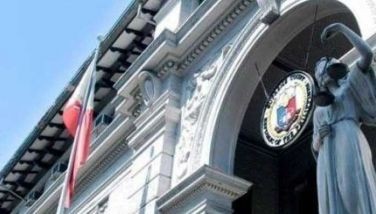Ernest Santiago: A life of giving
Taray was probably the most popular and evocative word in
It reflected the zeitgeist of that era, a Renaissance of the arts when bold experimentation and innovation was the norm.
Not surprisingly, Taray was also the term of endearment for Ernest Santiago, an icon in the fashion and lifestyle universe. It was he who put
Reinventing Philippine tropical hacienda interiors with an edge, he created an entertainment playground for the rich, the beautiful and the chic.
Playing the latest music that you would hear at Studio 54 in
But it would also include young, budding Filipino fashion designers and struggling artists whom he would take under his wing, encourage and nurture.
Larry Leviste, fashion designer and writer recalls fondly, “Ernest was my gay mom. The private ‘Tarurit’ was unselfish, caring and tender. Ramon San Agustin (now manager of Gucci at
Aside from bringing
Imee Marcos wore them to the Manila International Film Festival, catching the attention of
With this resurgence of Filipiniana fashion, dormant industries like piña and banana fiber weaving and embroidery had a new lease on life, providing employment to many and preserving our heritage crafts in the process.
At its zenith, Ernest’s shop was proudly called “Santiago de Manila” on
Aside from his own creations, he would encourage young designers to design their own lines for the shop.
Fashion designer Lulu Tan-Gan credits Ernest as one of her inspirations as a young designer in the 1970s all the way to this day when she just opened a Filipino concept store, “L Manila” at GB5.
“Ernest is a true icon who created the most famous address in
Aside from the disco and his shop, Ernest also opened ZeeZee Bar on the circle, completing his lifestyle empire.
This was way before lounges became fashionable, proof that Ernest was always ahead of everyone else. ZeeZee was the place to meet
As the disco era started to wane in the 80s, Ernest was not one to slow down and retire. He chanelled his energies to interior and furniture design and landscaping. He always had a talent for putting antiques and architectural fragments from old houses together in his characteristic flamboyant style, but always with comfort in mind as he loved entertaining friends and guests.
Film director Don Escudero recalls, “One stormy night in
Aside from designing resorts in Boracay and
In the 1990s, Ernest moved to Pagsanjan where he renovated a 1960s house into yet another amazing space which showcased his sculptural furniture.
He also opened a restaurant in the front part of the house called Gallery 83, serving good old Filipino comfort food like his sinigang sa kamatis, a favorite which he would make, lovingly mashing tomatoes with the beef to tenderness in a rich, sour broth as only he could make it.
He also had a fabulous pako (fern) salad with singkamas which is so refreshing on a hot summer’s day. Unknown to many is that Ernest’s first job at 12 years old was a cook and mayordomo to a family with a brood of growing kids who just adored his cooking.
After that, he worked at the Clover Theatre as assistant to the vaudeville star, Katy dela Cruz. It was there where he got training in the theatre arts which provided a lifelong penchant for the theatrical and the dramatic.
His entry into fashion was also largely self-taught, without studying in a fashion school as other designers do. But when he did get into something, he always did it in his characteristic “taray” way, defying conventions and surprising everyone in the process. True enough, he got the prestigious Ramon Valera award for one of his gowns.
Just when we thought Ernest had done it all, he called us last week for what turned out to be the crowning jewel in his lifestyle empire: The Kilib Food Sanctuary resort in Quezon.
It was a soft opening for close friends which included Irene Marcos-Araneta, Bernice Romualdez-Ocampo, Kuh Ledesma and daughter Isabel, fashion designers like Cesar Gaupo and Tonichi Nocum, and of course his “daughters” Larry Leviste, Ramon San Agustin and Henri Calayag.
Fusing Asian and Filipino design elements, Ernest built pavilions in a tropical garden setting which we were so sad to leave after a relaxing day partaking of Ernest’s sumptuous cuisine and unparalleled hospitality.
Alas, this was to be our last party with Ernest. We got a text Sunday morning from Anjo, his assistant, that Ernest had been murdered in his sleep.
A friend, Gigi De Jonghe called and said she was distraught. She remembered Ernest telling her that a fortune teller warned him about not buying property as this would be the cause of his death.
It turned out this was the reason Ernest would never stay put in one house and always rented. The prophecy always haunted him, it seems. But then why did he buy the Kilib property? Did Ernest feel that in his old age the prophecy would no longer hold true? Whatever it was, Kilib was just something he had to do as a final act of creation to share with his friends.
Gigi recounted that Ernest even called her after the party and in his motherly way, asked if Louis, her Belgian husband, liked the food, and if they enjoyed their stay in the resort. Larry, on the other hand, was so touched by Ernest’s concern for his health since he just underwent surgery. Leaving Kilib, he also asked us what we thought, and if we really enjoyed ourselves.
These were final acts of caring from a dear friend who gave us many years of wonderful parties at beautiful houses, restaurants, bars and discos. And what a gift he gave us: a beautiful resort showcasing Filipino design, culinary arts and hospitality as only Ernest knows how. Taray indeed, till the end!
- Latest
- Trending




























